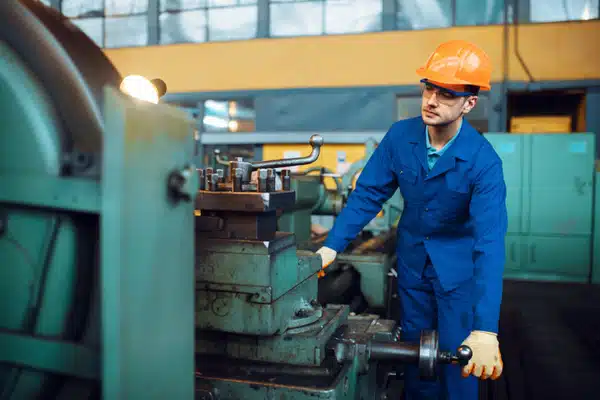
Early Warning Clues of Mechanical Seal Failure and Quick Fix Tips
Mechanical seals prevent fluid from escaping along rotating shafts in pumps and equipment. When these seals start to fail, quick action can save you from costly downtime and safety risks.
A mechanical seal works by pressing two flat surfaces together. One seal face attaches to the rotating shaft. The other stays stationary in the pump housing. A thin film of fluid between these faces provides lubrication.
Modern sensors can detect seal problems in real time. But nothing beats the trained eye of a maintenance professional who knows what to look for.
Key Warning Signs That Signal Trouble
Visible Seal Leakage
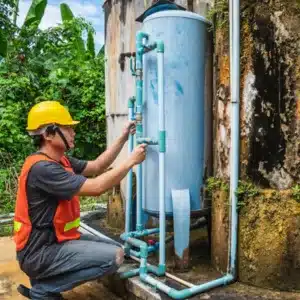 Visible seal leakage is the clearest warning sign in any pump operation. A healthy mechanical seal runs drip-free; if you identify a sheen of oil, spray of process fluid, or droplets carried on the shaft, the faces are no longer sealing. Scaling on metal parts, rising temperature, or an inadequate flush often causes the breach. Technicians rely on early detection to assist maintenance crews and prevent costly downtime. Investigate the process parameters immediately and identify faulty material choices before more damage can happen.
Visible seal leakage is the clearest warning sign in any pump operation. A healthy mechanical seal runs drip-free; if you identify a sheen of oil, spray of process fluid, or droplets carried on the shaft, the faces are no longer sealing. Scaling on metal parts, rising temperature, or an inadequate flush often causes the breach. Technicians rely on early detection to assist maintenance crews and prevent costly downtime. Investigate the process parameters immediately and identify faulty material choices before more damage can happen.
Strange Noises During Operation
Strange noises mark deeper trouble. A squeal means the faces are running dry without fluid lubrication, generating excess heat and wear. Popping or crackling tells you liquid is flashing to vapor under sudden pressure changes between the faces. If your pump suddenly sounds like it’s running dry, shut down and inspect before full failure spreads across bearings, shaft, and process line.
Excess Heat Around the Seal
Excess heat around the seal is a red flag that mechanical seals are failing. Overheating occurs when the flush process breaks down, starving the faces of coolant; rapid friction soon occurs again, driving temperatures higher. Heat checking and blistering scar the carbon faces, and repeated blistering can lead to cracks that require the seal to be replaced. Burnt material odors or wisps of smoke confirm failure will soon happen. Temperature alarms in the operating zone give early warnings, letting crews act before catastrophic damage.
Abnormal Vibration Patterns
Abnormal vibration signals seal problems. Vibration from bearings or pump cavitation strains mechanical seals. It knocks seal faces out of alignment, causing seal face damage. Failure adds shaft runout misaligning the seal. High vibration puts the mechanical seal at risk. Review the seal and main cause before damage spreads through the system line.
Physical Wear on Seal Components
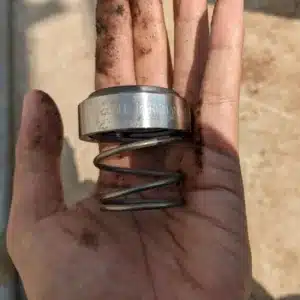 Grooves or scoring on seal faces reveal abrasive wear and open leak paths. Uneven tracks suggest misalignment, while cracks or chips on hard rings warn of imminent mechanical seal failure. Black carbon dust near the gland shows a carbon seal face running dry, early proof of lack of cooling and blistering.
Grooves or scoring on seal faces reveal abrasive wear and open leak paths. Uneven tracks suggest misalignment, while cracks or chips on hard rings warn of imminent mechanical seal failure. Black carbon dust near the gland shows a carbon seal face running dry, early proof of lack of cooling and blistering.
Barrier Fluid Loss in Dual Seals
These need vigilant barrier-fluid checks. Falling level or pressure signals inner seal leakage; in buffer systems, rising reservoir fluid marks primary leaks. Any sudden shift flags seal failure in progress.
Quick Actions to Address Seal Failure
Restore Proper Lubrication
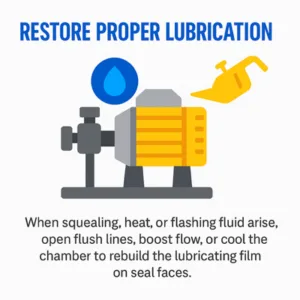 Swift action avoids mechanical seal failure. When squealing, heat, or flashing fluid arise, open flush lines, boost flow, or cool the chamber to rebuild the lubricating film on seal faces. Raise pressure if needed.
Swift action avoids mechanical seal failure. When squealing, heat, or flashing fluid arise, open flush lines, boost flow, or cool the chamber to rebuild the lubricating film on seal faces. Raise pressure if needed.
Check Alignment and Fix Vibration
Then shut the pump and check alignment; laser tools eliminate side loads, and new bearings stop shaft play that leads to leakage. Clear suction and discharge lines to end cavitation. These moves address the root cause factors such as temperature, vibration, wear, and pressures, keeping the system operating until permanent repairs.
Stabilize Operating Conditions
Check discharge and suction gauges immediately. Higher-than-normal discharge might mean the pump is dead-headed. Open valves or bypasses to relieve excess pressure before the seal malfunctions.
Ensure adequate suction pressure to prevent cavitation. You might need to reduce pump speed temporarily or remove suction blockages.
Verify that stuffing box pressure stays within seal limits. Avoid sudden thermal shocks that can crack seal components.
Avoid Over-Tightening
Don’t grab a wrench when you see leakage. Over-tightening can crush delicate seal rings and O-rings. This creates more leakage or immediate failure.
Over-tightening also compresses springs and throws off seal face balance. This makes seals run hotter and wear faster.
Use proper torque specs when adjusting fasteners. Sometimes slightly loosening bolts can help faces realign and reduce leaks.
Maintain Support Systems
For double seals, use the support system to manage weakened seals. Top up barrier fluid reservoirs to maintain pressure differentials. This helps outer seals hold back leakage longer.
Keep cooling coils and seal pots working properly. A healthy support system buys time to schedule repairs rather than react to emergencies.
Address Contamination Issues
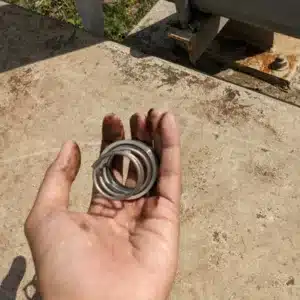 Chemical attack on seal faces or elastomers requires immediate action. Flush the pump with clean, neutral fluid to stop chemical reactions until you can replace the seal with proper materials.
Chemical attack on seal faces or elastomers requires immediate action. Flush the pump with clean, neutral fluid to stop chemical reactions until you can replace the seal with proper materials.
If abrasive solids are scoring seal faces, filter or flush out particles. In dirty services, introduce clean flush liquid to improve seal life.
Minimize exposure of seals to aggressive fluids through flushing or temporary process changes.
Plan for Permanent Solutions
Quick fixes keep pumps running until planned downtime allows maintenance.
Perform cause analysis; record conditions and causes. Knowing the causes prevents repeats.
Was failure from fluid lubricity, pressure swings, or install errors? Answers guide corrections, improved procedures, filters, designs.
Early detection shields equipment. Modern monitors help, yet sight, sound, and touch remain vital.
Stay alert; pair quick fixes with upgrades to extend mechanical seals’ life and keep pumps safe.
Act now and prevent costly seal failures. Call a pump team to inspect components, prevent leakage and unplanned downtime, and plan proactive maintenance.
